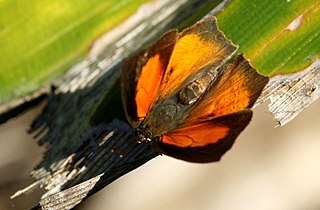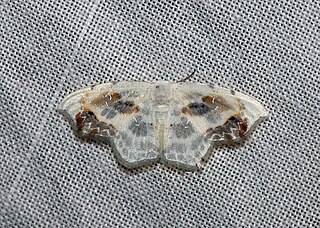
Curetis acuta, the angled sunbeam, is a species of butterfly belong to the lycaenid family. It is found in Indomalayan realm. Curetis acuta is sexually dimorphic, the sexes differing in dorsal coloration of the wings, however their ventral wings are similar and of silver color which reflects sunlight. The reflection of light by silver ventral wings plays a role of signalling during flight, camouflage while at rest or during hibernation, and lowering body temperatures by reflecting the sunlight.

The Bird’s Wing(Dypterygia scabriuscula) is a moth of the family Noctuidae. The species can be found in Europe and the western Palearctic.

Aporandria is a monotypic moth genus in the family Geometridae described by Warren in 1894. Its single species, Aporandria specularia, was first described by Achille Guenée in 1857. It is found in Sri Lanka, India, Vietnam, Thailand, the Andamans, Peninsular Malaysia, Sumatra, Borneo, the Philippines and Sulawesi.
Spectroreta is a monotypic moth genus belonging to subfamily Drepaninae erected by Warren in 1903. Its only species, Spectroreta hyalodisca, was described by George Hampson in 1896.

Grammodes stolida, the geometrician, is a moth of the family Erebidae. The species was first described by Johan Christian Fabricius in 1775. It is found in Africa, southern Europe, most of Asia and Australia. It migrates to central and northern Europe as far north as England, Denmark and Finland.
Amphitorna castanea is a moth in the family Drepanidae. It was described by George Hampson in 1891. It is found in India's Nilgiri Mountains.
Drapetodes interlineata is a moth in the family Drepanidae. It was described by Warren in 1896. It is found in Singapore, on Peninsular Malaya and in Indonesia (Java).

Leucoblepsis renifera is a moth in the family Drepanidae. It was described by Warren in 1900. It is found on Peninsular Malaysia, Sumatra and Borneo.
Nordstromia humerata is a moth in the family Drepanidae. It was described by Warren in 1896. It is found in north-eastern India.
Gogana abnormalis is a moth in the family Drepanidae first described by Warren in 1897. It is found on Borneo, Sumatra and Peninsular Malaysia.
Oreta bicolor is a moth in the family Drepanidae. It was described by William Warren in 1897. It is found in Sundaland and Malaysia.
Habrona marmorata is a moth in the family Drepanidae. It is widely distributed in Papua and Papua New Guinea.
Euchaetis endoleuca is a moth in the family Oecophoridae. It was described by Edward Meyrick in 1888. It is found in Australia, where it has been recorded from South Australia and Western Australia.
Catacometes hemiscia is a moth in the family Oecophoridae. It was described by Edward Meyrick in 1883. It is found in Australia, where it has been recorded from New South Wales.
Garrha cholodella is a moth in the family Oecophoridae. It was described by Edward Meyrick in 1883. It is found in Australia, where it has been recorded from New South Wales.
Garrha costimacula is a moth in the family Oecophoridae. It was described by Edward Meyrick in 1883. It is found in Australia, where it has been recorded from Queensland and New South Wales.
Garrha leucerythra is a moth in the family Oecophoridae. It was described by Edward Meyrick in 1883. It is found in Australia, where it has been recorded from New South Wales and Tasmania.
Striginiana nobilis is a moth in the family Eupterotidae. It was described by William Jacob Holland in 1893. It is found in Gabon.
Lichenaula laniata is a moth in the family Xyloryctidae. It was described by Edward Meyrick in 1890. It is found in Australia, where it has been recorded from New South Wales and Queensland.
Agriophara fascifera is a moth in the family Depressariidae. It was described by Edward Meyrick in 1890. It is found in Australia, where it has been recorded from New South Wales.




